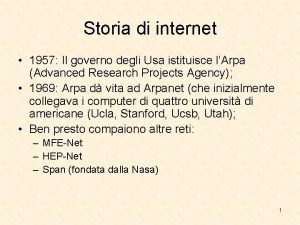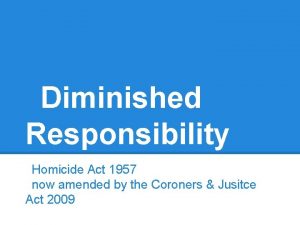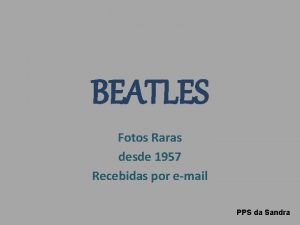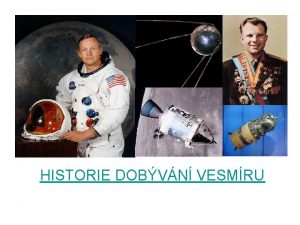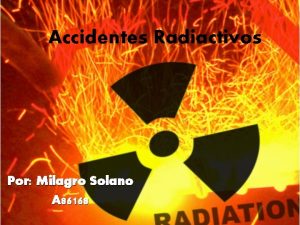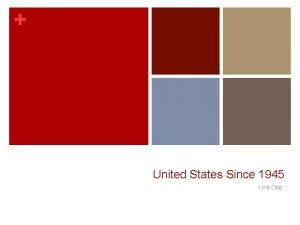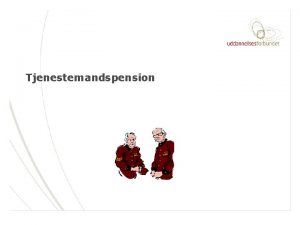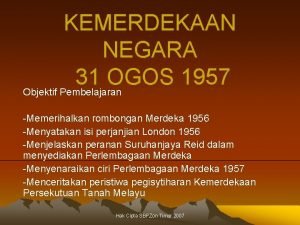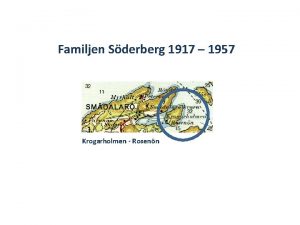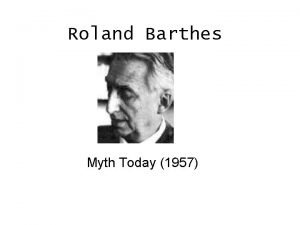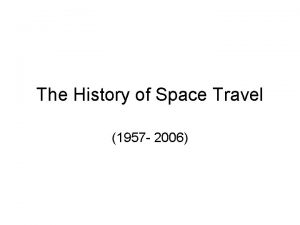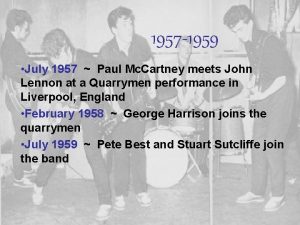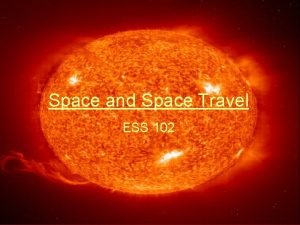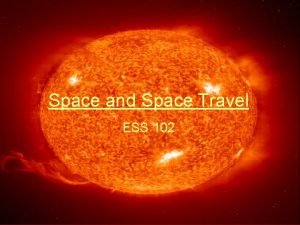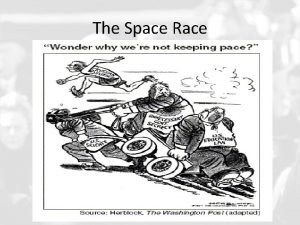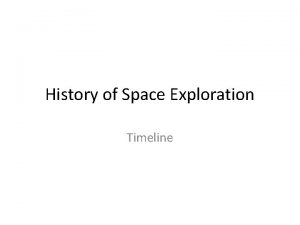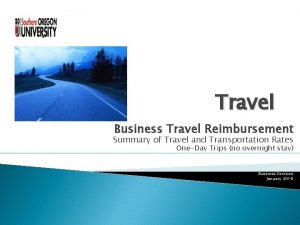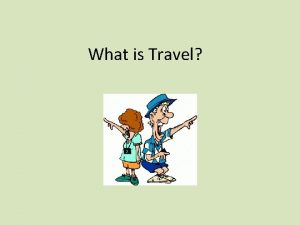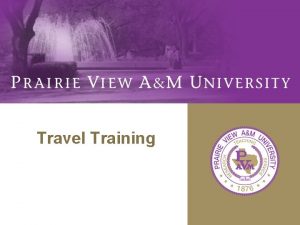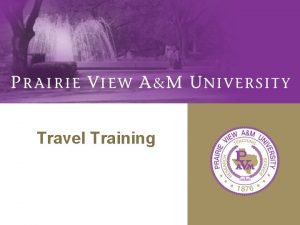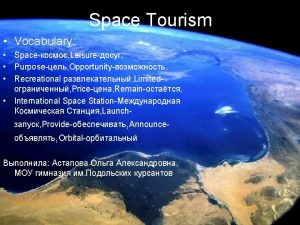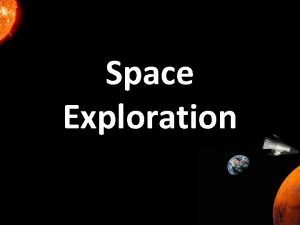The History of Space Travel 1957 2006 www
































- Slides: 32

The History of Space Travel (1957 - 2006) www. assignmentpoint. com

The 1950 s • During the Cold War the USA and the USSR competed in everything from getting Gold medals in the Olympic Games to who would win the space race www. assignmentpoint. com

Sputnik (1957) • The Russians were the first nation to put a satellite in space • The Americans worried that nuclear weapons could be sent into space • It took 98 minutes to orbit the Earth www. assignmentpoint. com

Laika Sending Laika into space proved that animals could survive weightlessness and the launch • Laika was a stray Russian dog • She was the first animal sent into space • Laika died a few hours into the flight from overheating www. assignmentpoint. com

American Monkeys in Space • Before Humans could be sent into space other animals were sent • Gordo the squirrel monkey survived his flight, but died (1958) when his parachute did not open • Able (top right (died the following month) and Baker (lived another 24 years) were the first animals to survive space flight • http: //news. bbc. co. uk/ont hisday/hi/dates/stories/m ay/28/newsid_3725000/3 725961. stm (Video) www. assignmentpoint. com

Yuri Gagarin • In 1961 the USSR put the first man in space • The Soviet Cosmonaut orbited the Earth for 118 minutes at 17, 000 mph • He was never allowed to fly again • http: //news. bbc. co. uk/onthisday/hi/dates/stories/april/12/newsi d_2477000/2477715. stm www. assignmentpoint. com

www. assignmentpoint. com

The Vostok 1 Capsule The Launch www. assignmentpoint. com

The First Man on the Moon • The Russians put the first satellite, animal and man in space, the Americans had to be the first to put men on the moon • They launched on July 16 th 1969 (600 million people watched) • Armstrong and Aldrin walked on the moon on 21 st July ( Video) • They spent 21 hours on the moon, 2½ hours outside • They returned to the Earth on 24 th July http: //news. bbc. co. uk/onthisday/hi/dates/stories/july/21/newsid_2635000/2635845. stm www. assignmentpoint. com

www. assignmentpoint. com Commander Neil Armstrong, Michael Collins, Buzz Aldrin

The Saturn V, the rocket that took the Apollo 11 mission to the moon. The rocket broke into 3 parts, one with fuel, the command module and the lunar module. Rockets only lasted for one mission, part of the Saturn V is still floating through space and part of it is at the bottom of the Pacific Ocean www. assignmentpoint. com

Buzz Aldrin poses for a picture, Neil Armstrong can be seen in his visor, taking the picture www. assignmentpoint. com

Buzz Aldrin stands beside the US flag www. assignmentpoint. com

Aldrin doing experiment, the lunar module is in the background www. assignmentpoint. com

The Lunar module, the Eagle, returning to the command module the Columbia. The Earth and the moon can be seen in the background www. assignmentpoint. com

The Columbia crashed into the Pacific Ocean and the astronauts were rescued by American Navy frogmen The Astronauts were quarantined for three weeks in case they had brought back some alien disease www. assignmentpoint. com

The First Pictures of Mars • The American Viking 1 (1976) space craft captured the images of the Red planet It worked up until 1982 when NASA scientists made a mistake reprogramming the batteries www. assignmentpoint. com

Voyager 1 and 2 (1977) • These two spacecraft were sent into space in 1977 • They were sent at a time when the planets were almost aligned (this speeded them up) www. assignmentpoint. com

Saturn’s Rings (1980) • The Voyager 1 took photos of Saturn • Titan (one of Saturn’s moons) has an atmosphere www. assignmentpoint. com

The Space Shuttle (1981) • • 1. 2. 3. 4. 5. It replaced the Rocket because most of it was reusable There have been 5 Space shuttles; Columbia launched in 1981(destroyed 2003) Challenger launched 1983 (exploded 1986) Discovery launched 1984 Atlantis launched 1985 Endeavour launched 1992 (as a replacement for Challenger) • http: //science. howstuffworks. com/space-shuttle. htm (How it works) • http: //news. bbc. co. uk/onthisday/hi/dates/stories/september/29/newsid_2542000/2542451. stm (Discovery take off 1988) http: //video. google. co. uk/videoplay? docid=8147866533180818812 (Columbia’s Maiden launch) • www. assignmentpoint. com

The Space Shuttle Atlantis taking off at Sunset, this is why the top of the smoke plume is red www. assignmentpoint. com Discovery, December 2006

Voyager 2 passes Uranus (1986) • A day was found to be 17 hours and 14 minutes long • A year on Uranus is 84 Earth Years www. assignmentpoint. com

The Challenger (1986) • http: //news. bbc. co. uk/onthisday/hi/dates/stories/january/28/newsid_2506000/2506161. stm (news reports) • 7 died as the Challenger exploded minutes after lift- off • • • http: //www. archive. org/details/Challenger. Accidentand. Investigation http: //spaceflightnow. com/challenger/timeline/ http: //www. spacetoday. org/Spc. Shtls/Challenger. Explosion 1986. html (video) • It was the second Space shuttle • It exploded due to faulty O-rings and cold temperatures www. assignmentpoint. com

Voyager 2 reaches Neptune (1989) • It appears blue because of it’s Methane atmosphere • http: //news. bbc. co. uk/onthisday/hi/dates/stories/august/25/newsid_2535000/2535545. stm www. assignmentpoint. com

The Hubble Telescope (1990) • Can see objects 14 billion years ago • It had to be repaired in space in 1993 • It has produced images of Stars being born and dying www. assignmentpoint. com

The Eagle Nebula is 7, 000 light years away www. assignmentpoint. com

The Horsehead nebula, 1, 500 light years away www. assignmentpoint. com

The Cat’s Eye Nebula, 3. 3 kilo Light Years away www. assignmentpoint. com

Andromeda Galaxy www. assignmentpoint. com

Columbia (2003) • http: //news. bbc. co. uk/onthisday/hi/dates/stories/february/1/newsid_3416000/3416589. stm (BBC News Coverage) • The Space Shuttle Columbia burned up on re-entry to the Earths atmosphere • A ceramic heat tile has become loose on take-off • Seven astronauts were killed • Debris from the explosion landed in car parks, forests and even a dentist’s office • Columbia was launched 22 years ago as the first space shuttle www. assignmentpoint. com

www. assignmentpoint. com

The Columbia’s Re-entry • Ceramic tiles on the underside of the shuttle make a heatproof shield • Friction with air molecules heats the shuttle to 1, 500°C www. assignmentpoint. com
 Internet 1957
Internet 1957 Explain the tragic irony that occurs in the exodos.
Explain the tragic irony that occurs in the exodos. Ola 1957 section 2
Ola 1957 section 2 1957 internet
1957 internet Fortran 1957
Fortran 1957 Homicide act 1957
Homicide act 1957 Frank rosenblatt perceptron
Frank rosenblatt perceptron Beatles fotos raras desde 1957
Beatles fotos raras desde 1957 Sales of good act 1957
Sales of good act 1957 Cpm/pert (dupont 1957)
Cpm/pert (dupont 1957) James vicary 1957 experiment
James vicary 1957 experiment Jata negara
Jata negara 4 10 1957
4 10 1957 1957: mayak (rusia), magnitud 6 según la escala ines.
1957: mayak (rusia), magnitud 6 según la escala ines. Little rock 1957
Little rock 1957 Kurikulum 1946, kurikulum 1957, dan kurikulum 1961
Kurikulum 1946, kurikulum 1957, dan kurikulum 1961 Folkepensionsalder født 1961
Folkepensionsalder født 1961 Sejarah tahun 5 penjajahan dan campur tangan kuasa luar
Sejarah tahun 5 penjajahan dan campur tangan kuasa luar Cpm/pert (dupont 1957)
Cpm/pert (dupont 1957) Penyata penyesuaian amanah
Penyata penyesuaian amanah Kemerdekaan negara 31 ogos 1957
Kemerdekaan negara 31 ogos 1957 Contoh gangguan seksual
Contoh gangguan seksual Productividad de la administracion
Productividad de la administracion Ansoff matrix theory
Ansoff matrix theory 1957-2008
1957-2008 Filtersand rusta
Filtersand rusta 1957 internet
1957 internet Roland barthes 1957
Roland barthes 1957 Impressionism apush
Impressionism apush Joint space vs cartesian space
Joint space vs cartesian space Space junk the space age began
Space junk the space age began Camera space to world space
Camera space to world space Cartesian space vs joint space
Cartesian space vs joint space
